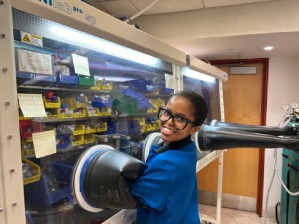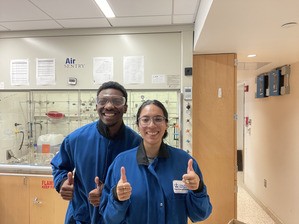Two Engineering Students from Howard Try Their Hands at Chemistry at Columbia
Owethu Bukula and Quentin Taylor on their summer as NSF REU students with Columbia’s MRSEC on Precision-Assembled Quantum Materials.

Every summer, Columbia’s National Science Foundation (NSF)-funded Materials Research Science and Engineering Center on Precision-Assembled Quantum Materials welcomes undergraduates to campus as part of the NSF’s Research Experience for Undergraduates (REU) program. This year’s cohort of REUs included rising senior Owethu Bukula and rising sophomore Quentin Taylor from Howard University in Washington, DC.
DC is practically Taylor’s backyard as a resident of Prince George’s County, Maryland, while Bukula hails from abroad: Johannesburg, South Africa. These two engineering majors—mechanical for Bukula, chemical for Taylor—spent their time in New York in the labs of Columbia chemists Xavier Roy and Colin Nuckolls.

Bukula, Taylor, and their fellow REUs presented their work on August 2nd. Before they headed back to DC to start the fall semester, they reflected on their time at Columbia.
What inspired you to pursue engineering degrees at Howard?
Owethu Bukula: My dad was an electrical engineer, and my mom encouraged me to do anything I wanted. I chose mechanical engineering because I like the versatility of it, and the overlap with materials science. I had been to the United States a few times growing up, and I knew I wanted to study here. A friend was applying to Howard, so I decided to as well.
Quentin Taylor: My parents are both computer engineers who tried to push me in their footsteps. I didn’t want to do exactly that, but always being surrounded by STEM in my childhood definitely put me on a science path. I was a big fan of chemistry in high school, so I decided to study chemical engineering in college—I like that it’s a broad discipline. I chose Howard because of the Karsh Scholars Program, which supports students on a path to a STEM PhD.
Describe your REU projects.
QT: I worked with rhenium selenium chloride, which is a 2D material that can be cross-linked to make 3D structures with different properties. I learned how to synthesize organic molecules called macrocycles that can link rhenium selenium monolayers together.
Learn More About The Labs In This Story
OB: I worked on intercalating lithium to a 2D material called chromium sulfur bromide, which changes its magnetic properties. The next step was to see if any of its electrical properties changed, which involved testing the material using different measurement techniques and machines. I also worked on device fabrication to study different 2D materials. I learned how to make these devices in a glovebox and test them using the VERSA lab
How was your experience in the lab?
OB: This was my first immersion in a lab. Columbia is doing really innovative work in 2D materials, and it was an opportunity I couldn’t miss. I learned a lot of lab skills, like making devices and working in air-free zones. This is a very tiny business. Everything has to be done under a microscope using micromanipulators.
It was also surprising how much independence I had. As an undergraduate, you are used to a professor guiding you at every step. Here, my mentors taught me the basics, and then trusted me to figure out the rest.
QT: I had done some computer-based testing on materials in my research lab on Howard University’s campus my freshman year, but at Columbia I had my first experience in a wetlab doing organic synthesis. This was my first exposure to organic chemistry, so I jumped over the preliminary learning. I would run an experiment, then go open up my textbook to make sure I understood the science of what I just did.
I also learned how important trial-and-error and repetition are in a lab. You can follow the same steps and sometimes things work…sometimes they don’t.
Any favorite places in New York?
QT: All the parks surprised me. My brother went to school in Brooklyn and gave me the impression of New York as a concrete and asphalt jungle. I like Central Park a lot, and really enjoyed visiting the Brooklyn Botanic Gardens and Flushing Meadows-Corona Park.
OB: I love sightseeing and exploring—there’s so much to do. I recently visited the Whitney Museum and the Brooklyn Bridge—I’d say those have been my favorite places.
So what’s next for you?
OB: I’ve reached out to professors at Howard about joining their labs. I want to stay in this kind of environment, because I really have enjoyed myself. I’m also looking at graduate programs. I’m interested in sustainability, especially sustainable energy, which is a big issue in South Africa. I hope to return home someday and pay my education forward.
QT: I’d like to attend a scientific conference, and explore what other kinds of research I can do. I plan to continue my education, and I can see myself pursuing a PhD with a focus on materials science. To make breakthroughs in science, you need materials.
Any tips to share for future MRSEC REUs?
QT: Your PI and their postdocs and graduate students are great people to learn from, about science and beyond. For example, they talked to me about how graduate school works and what to expect. Seek out their advice.
OB: I came in very nervous. I hadn’t done chemistry in a while! But this experience is about learning and immersing yourself. Don't focus too much on what you do or don't know, but about what you are going to learn. That's way more exciting, and it takes the nerves off.
